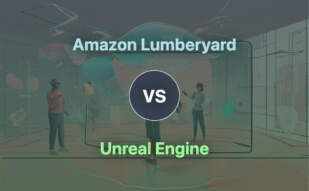CryEngine is a versatile game development engine known for its photorealistic graphics, open-world environments, and wide genre support. It offers a royalty-free system and a robust set of tools for developers to create polished games. Developed by Crytek, it has been used in various popular games and is currently on version 3.8.6 available on Steam.

Exploring options beyond CryEngine, developers can consider Unreal Engine, Unity, Amazon Lumberyard, Stride, O3DE, Love2D, Heaps, Babylon.js, jMonkeyEngine, RPG Maker, GameSalad, GameMaker, Construct 3, Phaser, Roblox, SpriteKit, and Three.js.
Unreal Engine
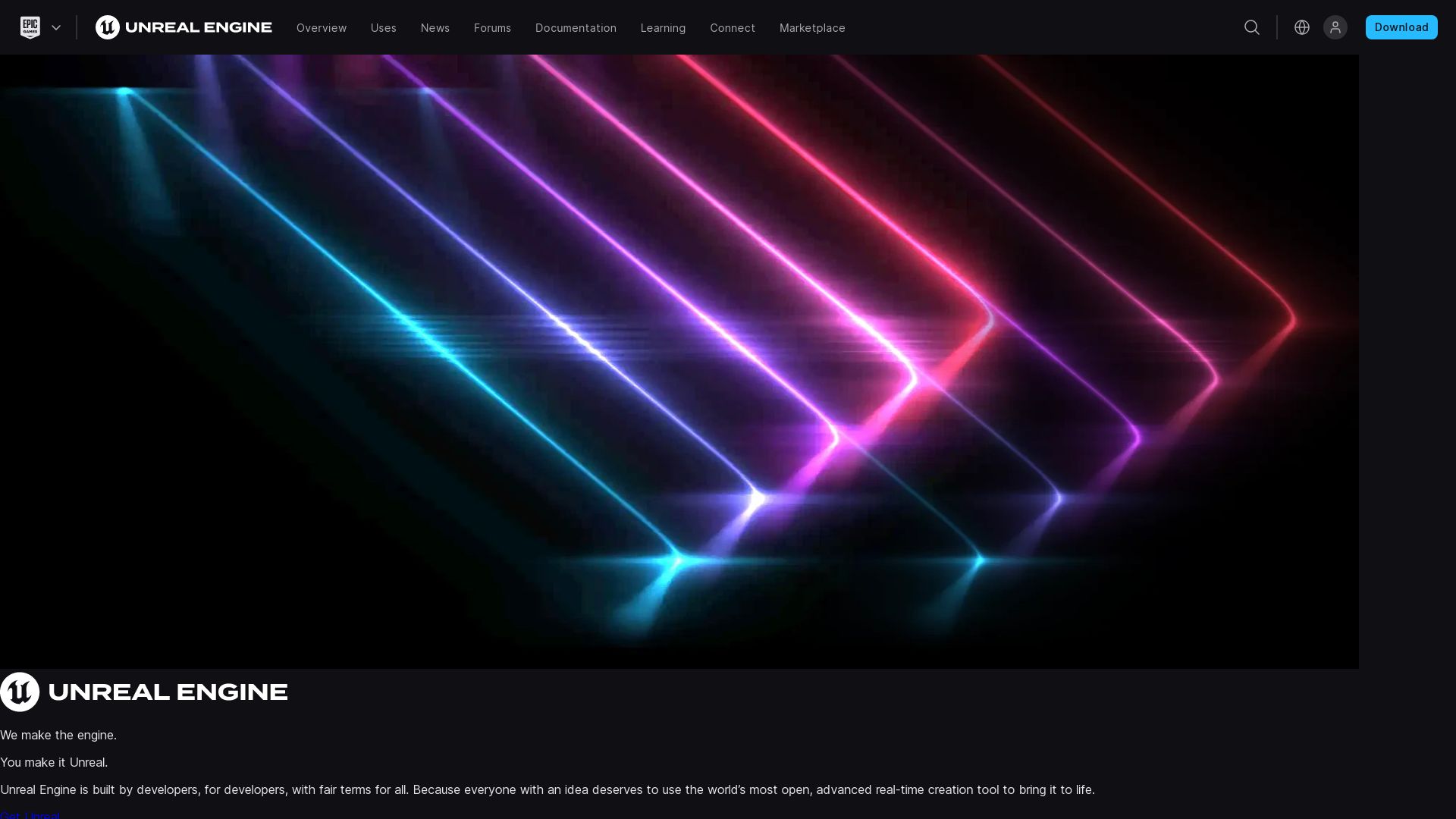
As a product of Epic Games, the Unreal Engine is a powerful series of 3D computer graphics game engines, first introduced in 1998 through the game Unreal. With its programming language in C++, UE has spread its wings beyond PC first-person shooters to varied game genres and industries inclusive of film and television.
Unreal Engine Best Features
- Extended platform support covering desktop, mobile, console, and virtual reality.
- Inclusion of Unreal Editor (UnrealEd), designed for real-time constructive solid geometry operations.
- Integration of Unreal Development Kit (UDK), supporting the development of iOS games and apps.
- Empowerment to modders with an open structure, as experienced in Unreal Engine 3.
- Incorporation of acquired company features, evident with Quixel.
| Feature | Benefit |
|---|---|
| Unreal Engine Marketplace | Platform for developers to buy and sell their creations. |
| Revenue Share Model | 88% of marketplace sales belong to content creators. |
| Free for Educational Institutions | Schools and universities can use Unreal Engine free of cost. |
Unreal Engine Downsides
- 5% royalty charges on revenues exceeding USD 1 million for commercial usage
- The learning curve can be steep due to its advanced features and C++ programming requirement.
Unreal Engine Pricing
Unreal Engine 4 is free for all, imposing a royalty charge of 5% for products that earn more than $3,000 quarterly. However, Unreal Engine waives this royalty model for games published on the Epic Games Store.
Unreal Engine Use Cases
Use case 1 – Gaming
From PC first-person shooters to mixed-genre games, Unreal Engine is the backbone of a myriad of gaming experiences across platforms.
Use case 2 – Film and Television
Real-time rendering and versatile features of Unreal Engine cater to the demanding scenarios of the film and television industry.
Use case 3 – Education
Academic institutions find Unreal Engine a robust tool for teaching computer graphics, game development, and app creation.
Unity

Launched in 2005, Unity has become a dominant force in the world of game development engines. Adaptable across multiple operating systems, Unity empowers developers to create an array of applications, ranging from Augmented Reality to detailed 3D simulations.
Unity Top Features
- Platform versatility: Enables development of cross-platform games including Android and iOS platforms.
- Rich asset store: Integrated with a wide variety of pre-designed textures and features, facilitating creativity in game design.
- Coding support: Offers a variety of coding languages, including BOO script, Javascript, and C# for versatile development options.
- Active community: Unity has a robust developer community for problem-solving, feedback, and system improvement.
- AR/VR Enhancement: Encourages the development of games with augmented reality/virtual reality (AR/VR) features.
| Feature | Description |
|---|---|
| Technical Evolution | Continuously improving for user-friendliness, compatibility,and creating immersive visual experiences |
| Learning and Communication | Facilitates constant learning and exchange of industry solutions among users |
| Collaborative Adaptability | Emphasizes collaboration and adaptability among members for better game development |
Unity Limitations
- Pricing changes: Unannounced shifts in pricing cause uncertainty and can potentially affect the financial sustainability of developers.
- Fee imposition: The new retrospective fee model added stress among developers and weakened the trust relationship.
- Fee on instalments: Charging a fee each time a game using Unity software is installed raised fear among developers of potential abuse and added cost.
Unity Pricing
The company provides both free and paid versions of Unity. However, as of January 1st, 2024, a new pricing model will be operational which involves developers paying a fee for each game installation. This proven controversial, but Unity clarified that install fees will only apply after a game reaches $200,000 in revenue and surpasses 200,000 installations.
Unity Use Cases
Use Case 1 – Mobile Gaming
Unity is highly suitable for mobile developers due to its cross-platform compatibility and promotion of mobile game development. The integration of assets simplifies design brainstorming.
Use Case 2 – Indie Developers
Despite the concern over pricing, Unity provides options for indie developers with a free version and a large active community for problem-solving.
Use Case 3 – AR/VR Gaming
Unity’s commitment to the development of AR/VR applications makes it a preferred choice for creators in this field.
GameSalad
Directly emanating from Texas, the tech hub of the US heartland, GameSalad bridges the gap between dreaming and doing. It’s a free, drag-and-drop game creation engine that offers a playful yet educational approach to the art of game development, uniting developers across platforms from iPhone, iPad, Android to HTML5 games.
GameSalad Top Features
- In-App Previewer: Enables real-time testing of your game blooming with complex behaviors from an extensive library.
- Web Publishing System: Grants you the power to embody digital unity across platforms, offering your creative genius to players on Android, iOS, Windows, and Amazon Marketplace.
- GameSalad Pro: A premium suite capturing hearts from students, educators, and the US Military, courtesy of attractive discounts. It boasts social features and monetization options, opening doors to global prospects and profits.
| Scene Editor | Integrated Physics |
|---|---|
| Compose your game scene with a visual flare, transcending cultural and language barriers. | Create stunning, hyper-realistic interactive events that signify the universality of physics principles. |
| Expressions | Tables/Arrays for Mass Data Access |
| Express your creative ideas with the simplicity and immediacy of textual language. | Structure and manipulate a wealth of game data, unifying arrays of information into a smooth, accessible format. |
GameSalad Disadvantages
- Discontinued Free Memberships: Since 2015, the free-to-make model has been retired.
- Lay-offs: GameSalad experienced a challenging period in 2012 as half the workforce was laid off.
GameSalad Pricing
GameSalad, once acclaimed for its discerning ‘Free-to-Make’ model, has evolved. It has discontinued the free memberships in 2015 and now offers subscriptions to its feature-packed GameSalad Pro.
GameSalad Use Cases
Use case 1
Teaching Computer Science Concepts: With an established footprint at more than 223 schools, including prominent institutions such as Connally High School, Texas and James B. Conant High School, Illinois, GameSalad fosters an innovative, logic-based thinking environment.
Use case 2
Global Digital Competitions: Teaming up with Macworld Expo for the 2010 GameSalad Challenge, the platform extends its sphere of influence to a larger, competitive audience, echoing the global reach of digital unity.
Use case 3
STEAM Learning: Emphasizing the connection between the digital and physical world, GameSalad champions STEAM learning, encouraging students and educators to shape the next generation of games right inside their classrooms. Overlaying coding with creativity, it fosters a harmonious blend of skills for the future workforce.
GameMaker
Establishing its mark in 2D game engine sphere, GameMaker offers plenty to both beginners and full-fledged developers in terms of scalability, simplicity and vital tools.
GameMaker Top Features
- Language Server for Syntax Highlighting and Intellisense support empowering adaptability with more languages, including JSON, XML and Shader Languages (GLSL, HLSL).
- Anticipated 2023 updates, including AI support, enhanced modding capabilities, and a fresh code editor.
- Mod.io extension for easy incorporation of user-generated content into your game.
- AI Integration, made simpler via partnership with OpenAI.
| Feature | Description |
|---|---|
| Responsive Code Editor | New fullscreen association to objects, functions and events. |
| Community Commitment | Striving for game developer support and community development. |
GameMaker Limitations
- Prominently focused on 2D games, lowering versatility for 3D games.
- Despite ease of use, mastering the platform takes significant dedication and practice.
GameMaker Pricing
GameMaker affords a variety of tiers to cater to your specific developmental needs-namely Free, Creator, Indie and Enterprise.
GameMaker Use Cases
Use case 1 – Newcomer Entry into Game Development
For beginners stepping into game development, GameMaker offers a welcoming entry point via its simplicity and intuitive toolset.
Use case 2 – Advanced Game Development
Endowed with scalability, GameMaker caters to full-time developers for designing complex 2D games, tech rigidity notwithstanding.
Use case 3 – Indie Game Creation
Illuminated by indie hits like Undertale, GameMaker serves as a dependable canvas for an indie developer crafting the next sensation.
Construct 3

Wave a coding goodbye and welcome to the world of Construct 3, an HTML5-based 2D video game engine built for not just geeks but beginners too. Developed by Scirra Ltd, a brainchild of Ashley and Thomas Gullen founded in 2011, the engine helps you create visual masterpieces as games, while keeping things light and friendly.
Construct 3 Top Features
- Event Sheets: It’s like a cheat sheet for your game logic. Once your game meets certain conditions, these sheets trigger pre-defined actions. Less code, more fun!
- Platform Agnostic: Use it on any browser. Don’t want to be dependent on Wi-Fi? Download it for offline use.
- Pixel Editor: Want to create game graphics that make players go WoW? The in-built pixel editor is at your fingertips.
- HTML5 Support: No matter which browser you favor, Construct 3 has your back. It plays well with Chrome, Firefox, Safari, and Opera.
- JavaScript Integration: Not totally coding-averse? There’s an optional JavaScript integration just for you.
| Data Privacy | It respects your privacy by complying with COPPA, CCPA, and GDPR regulations, so you can keep your data private while gaming public. |
| Export Capabilities | Game created? Export it as a web app or wrap it in HTML. With ease! |
Construct 3 Downsides
- No 3D Game Support: Construct 3 keeps things in 2D. So, if your game needs depth, it might be a dampener.
- Device Dependent: Your game’s export for HTML5 and running on Construct 3 depends on the device’s web content support.
- Size Limit: Though versatile, Construct 3 may struggle when creating larger games.
Construct 3 Pricing
Good things in life aren’t always free, but some are cheap. The personal plan for Construct 3 begins at just $99/year. Still finding it pricey? There’s a free license version to get you started.
Construct 3 Use Cases
Use Case 1: Indie Developers
If you’re an indie developer looking for swift game creation with visual programming, Construct 3 is your buddy.
Use Case 2: Educators
Tearing your hair out over coding curriculum in schools? Give Construct 3 a try. Its easy programming process and downloadable feature make it a teachers’ pet in poor internet connectivity regions.
Use Case 3: Advertisers
Create playable ads with Construct 3, because why just talk about it when you can make people experience it.
Phaser
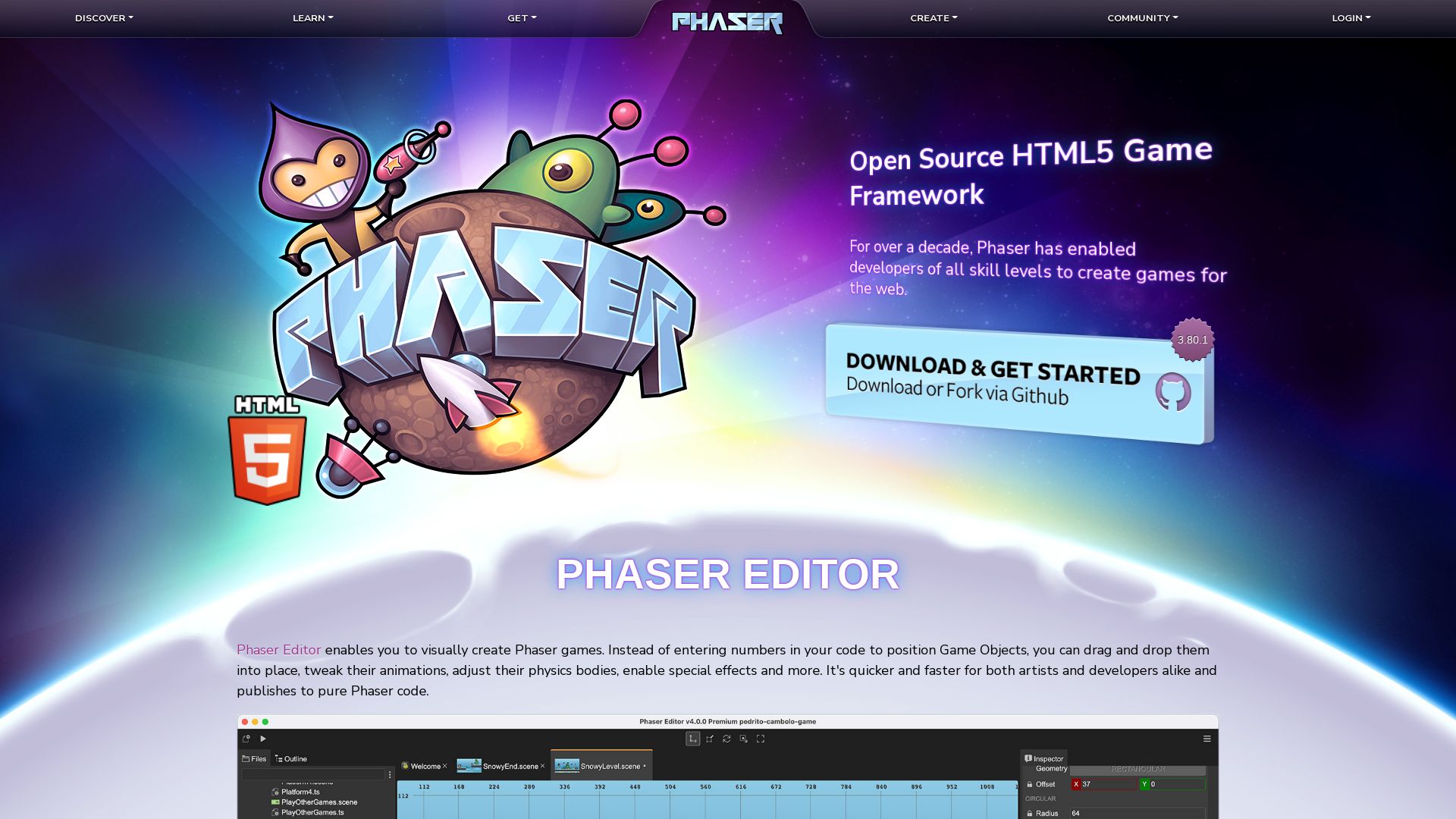
Welcome to the world of Phaser, a 2D game framework making strides in the realm of HTML5 games. Created by Richard Davey and initially released in April 2013, this versatile platform has become a go-to tool for game developers worldwide.
Phaser Top Features
- Wide range of support: Phaser games are deployable to iOS, Android, and native desktop apps via tools like Apache Cordova and PhoneGap.
- Intuitive rendering: Phaser utilizes Canvas and WebGL renderers for swift rendering and auto-switches based on browser compatibility.
- Multi-version availability: Phaser comes in multiple versions each with its own unique features and the latest, Phaser 4, is currently in the works.
| Compatible browsers | Any browser that supports the canvas element |
| Sound playback | Web & HTML5 audio |
| Learning resources | Over 1800+ examples and an active community |
Phaser Downsides
- Multiple support: Phaser offers many physics systems including Arcade, Ninja and P2.JS which might seem overwhelming to a novice.
- Advanced Skills: Phaser 3&4 require a better understanding of modern JavaScript, which can be challenging to learn for beginners.
Phaser Pricing
Fret not about pricing! Phaser is an open-source platform, making game development accessible to everyone.
Phaser Use Cases
Use case 1: Beginner Game Developers
Phaser with its rich learning resources and strong community support is a valuable starting point for beginners in game development. Its Phaser Mini-Degree from Zenva Academy is considered high-quality and beginner-friendly.
Use case 2: HTML5 Game Development
For those focussed on HTML5 game development, Phaser provides an intuitive framework with flexible usage options like es6+webpack and TypeScript.
Use case 3: Mobile Game Development
For mobile game developers, Phaser’s compatibility with iOS and Android adds a delectable feather to its cap, paving the way for the creation of cross-platform games.
Roblox

Roblox, the brainchild of David Bazsucki and Erik Cassel, stepped into the gaming terrain in 2006. Packed with a unique game creation platform, Roblox Studio, it’s known for its unwavering defiance of structured play by promoting an environment of unlimited imagination and mutual support. With over 100 million monthly active users, it’s the preferred vehicle to game development for millions.
Roblox Top Features
- A proprietary engine, Roblox Studio, for users to create games.
- Over 50 million user-generated games and robust social interaction features.
- Financially rewarding with projected payouts over $100M in 2019.
- Offers stunning compatibility with external software like Blender for advanced model creation.
- Empowers over 2 million creators that foster a vibrant sense of community.
- Strong safety measures with algorithms filtering sensitive information.
| Platform | Popular Titles |
|---|---|
| Windows, macOS, iOS, Android, Xbox One | Power Simulator, Munching Masters, Magician Simulator |
| Meta Quest 2, Meta Quest Pro, PlayStation 4 | Virtual worlds, Interactive experiences, Simulation games |
Roblox Downsides
- Reports of adult content and misuse by adult players.
- Under scrutiny for microtransactions and allegations of child-exploitative practices.
- Moderation issues.
Roblox Use Cases
Young Game Developers
Roblox serves as a beneficial platform for young and aspiring game developers. It provides them with the tools to design, build, and animate their dream games, promoting their creativity and skill development, all while keeping them cocooned in a safe environment.
Independent Developers and Small Businesses
With financial rewards for popular games, it proves to be a lucrative platform for independent developers and freelancers looking to monetize their creations. Small businesses can also utilize the platform to create engaging, interactive experiences for their audience.
Learning & Education
For those keen on learning game development, Roblox offers an array of resources, including online classes, published books, and YouTube tutorials. Its programming languages and basics of game development cater to both novices and advanced learners.
SpriteKit
![]()
SpriteKit is a high-powered game development framework exclusive to iOS and macOS, architected over SceneKit. It simplifies the creation of 2D games, using Swift language support and interactive physics-based gameplay.
SpriteKit Top Features
- Offers a user-friendly interface for creating and animating 2D game objects.
- Employs a Box2D physics engine for realistic object interactions.
- Compatible with Swift offering enhanced efficiency in coding.
- Comprises of four components: Scene, Node, Sprite, and Action.
- Provides a suite of features including scene editing, animation, physics and particle systems.
- Suitable for cross-platform game creation with Game Center and iCloud support.
- Maintains 64-bit architecture compatibility.
| Key Strength | Explanation |
|---|---|
| Using Swift | Efficient coding with Samples and SwiftUI support. |
| Physics Engine Implementation | Realistic object interaction with Box2D engine. |
| Future Device Support | Backed by Apple for future device compatibility. |
SpriteKit Limitations
- Rigorous efforts needed to build games for left-oriented players.
- Geared towards the Apple ecosystem, limiting platform diversity.
- Every enhancement in performance sacrifices collision accuracy and vice versa.
SpriteKit Pricing
As part of Apple’s game development frameworks, SpriteKit is available for free to all developers within the Apple ecosystem.
SpriteKit Use Cases
Use case 1 – Cross-Platform Game Development
Developers can leverage SpriteKit’s cross-platform game creation ability with Game Center and iCloud support, enabling games deployment across iOS and macOS.
Use case 2 – Swift Programming
Coders with expertise in Swift can utilize its efficient coding capabilities for accelerated game development.
Use case 3 – Ideal for MVPs and Analytics
For those requiring rapid prototyping or game analytics, SpriteKit offers speed, efficiency and doesn’t require handling of lower-level physics or building a proprietary cloud, making it a prime choice.
Three.js
Within the landscape of game development engines, Three.js unmistakably stands out. Created by the pioneering developer Ricardo Cabello, also known as Mr.doob, this open-source JavaScript library facilitates creation and display of profoundly immersive 3D computer graphics directly in a browser. It makes use of WebGL and GPU acceleration to yield intricate animations, all without needing any browser plugins.
Three.js Top Features
- Richly supporting Virtual and Augmented Reality via WebXR, making it suitable for VR/AR development.
- Outfitted with multiple effects, scenes, cameras, animations and shaders, providing a comprehensive range of tools for a developer.
- Offers WebGL 2.0 as a default from version 118, demonstrating its commitment to remain cutting-edge.
- Comes with an adaptive community of over 1700 contributors on Github, ensuring continuous enhancements and updates.
| Supports | All browsers compatible with WebGL 1.0 |
| Language | JavaScript, GLSL |
| License | MIT |
Three.js Limitations
- Limited to browsers that support WebGL 1.0, which may restrict reach over non-compatible platforms.
- A steep learning curve due to its extensive and sometimes complex features and functions.
Three.js Pricing
Carrying the spirit of community development forward, Three.js comes at no cost with its MIT License. This makes it an ideal choice for developers working within a budget constraint.
Three.js Use Cases
Use case 1
Excellent choice for game developers aiming to create browser-based 3D games.
Use case 2
With support for both Virtual and Augmented Reality, Three.js can be efficiently utilized in VR/AR application development.
Use case 3
Being a JavaScript library, it’s an asset for JavaScript developers aiming for high-performance 3D animations in their web projects.
Amazon Lumberyard

An offspring of Amazon Game Tech, Amazon Lumberyard served as a cross-platform game engine before evolving into the Open 3D Engine. Originally based on CryEngine, it later adopted an open-source license and grew into a free 3D, cross-platform (PlayStation 4, Xbox One, Windows, Linux, iOS, Android) game engine loaded with an array of custom-developed tools and integrations.
Amazon Lumberyard Top Features
- Integration with AWS: Backed by Amazon Web Services, providing robust backend support.
- Twitch Integration: Unique chat feature permits influencers to impact game dynamics.
- Advanced VR Support & Game Editing: Offers real-time gameplay editing and a VR preview mode.
- Fur Shader and Modular Gems: Among its custom-developed systems for realism and versatility.
| Feature | Description |
|---|---|
| Script Canvas Editor | A visual scripting environment for less technical game developers. |
| Animation Editor | Enables complex animation sequences for character and object behaviour. |
Amazon Lumberyard Downsides
- Its usage is limited to public release of its source code, placing a cap on creative freedom.
- The cost of AWS services can stack up, particularly for high traffic games.
Amazon Lumberyard Pricing
While Amazon Lumberyard is available for free, it charges for AWS usage. Specifically, you’ll pay $1.50 per 1,000 daily active users, on top of standard AWS fees.
Amazon Lumberyard Use Cases
Use Case 1: Cross-platform Game Development
Lumberyard’s cross-platform compatibility simplifies the process of designing games for multiple platforms, including Windows, PlayStation, and mobile devices. The result is a more efficient development cycle and reach to a broader audience.
Use Case 2: High Definition 3D Games
The engine’s advanced 3D modeling and Fur Shader tools can help developers create rich, realistic environments and characters, elevating graphics quality in games.
Use Case 3: Games with Heavy Online Integration
For games that rely heavily on online play, community interaction, or real-time updates, Lumberyard’s AWS integration and built-in Twitch support offer a potent package.
Stride
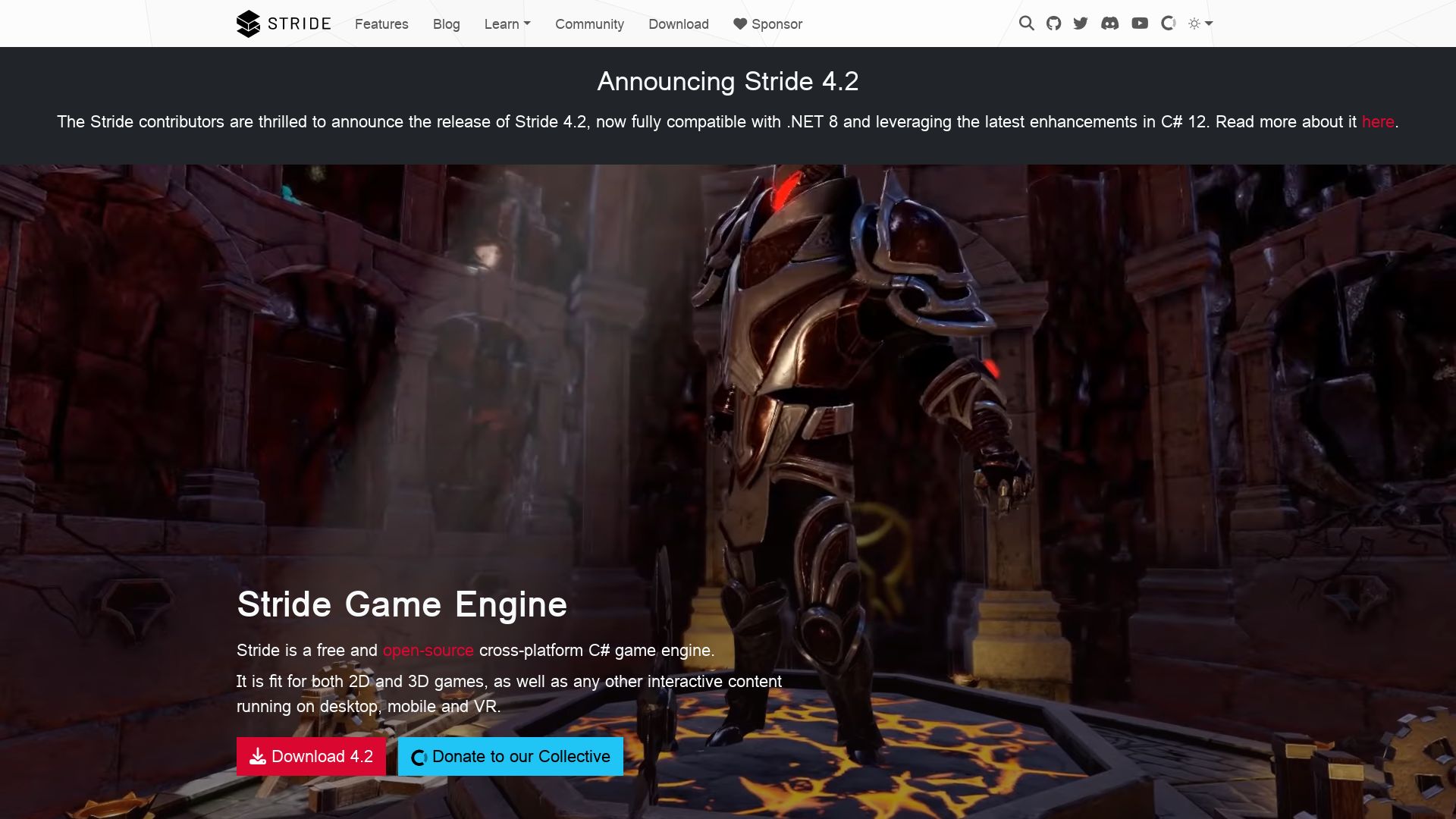
Initially named Xenko, Stride is a free, open-source, cross-platform game engine developed originally by Silicon Studio, used to create interactive 2D/3D video games for a variety of platforms.
Stride Top Features
- C# Suite tools: Equipped with a comprehensive suite of core tools, written in C# for enhanced development experience.
- Customizable Shader System: Enables developers to manipulate graphics rendering pipelines in real-time.
- Game Studio: An all-in-one development hub for asset import, scene creation, script assignment, game building and running.
| In-built Assets: | Offers a broad range of tools including PBR material editor, sprite editor, scripting editor and particle editor. |
| Cross-platform Runtime Support: | Stride operates across multiple platforms including Android, iOS, Windows UWP, Linux and PlayStation 4. |
Stride Limitations
- Dependence on community support for updates and improvements after Silicon Studio’s relinquishment of support in 2018.
- Depth of software features can be overwhelming for beginners in game development.
Stride Pricing
As an open-source game engine, Stride is entirely free to use for game developers. This open model allows universal access and the opportunity for developers to contribute to the engine’s development.
Stride Use Cases
Use Case 1
Stride, with its cross-platform support, robust tool-chain and flexible shader system is particularly useful for indie game developers working across multiple platforms.
Use Case 2
The engine is also perfectly tailored for 3D rendering requirements within the visual programming environment vvvv gamma.
Use Case 3
Furthermore, Stride’s comprehensive C# suite of tools and Game Studio makes it a powerful choice for advanced developers aiming to build complex, graphic-intensive games.
O3DE
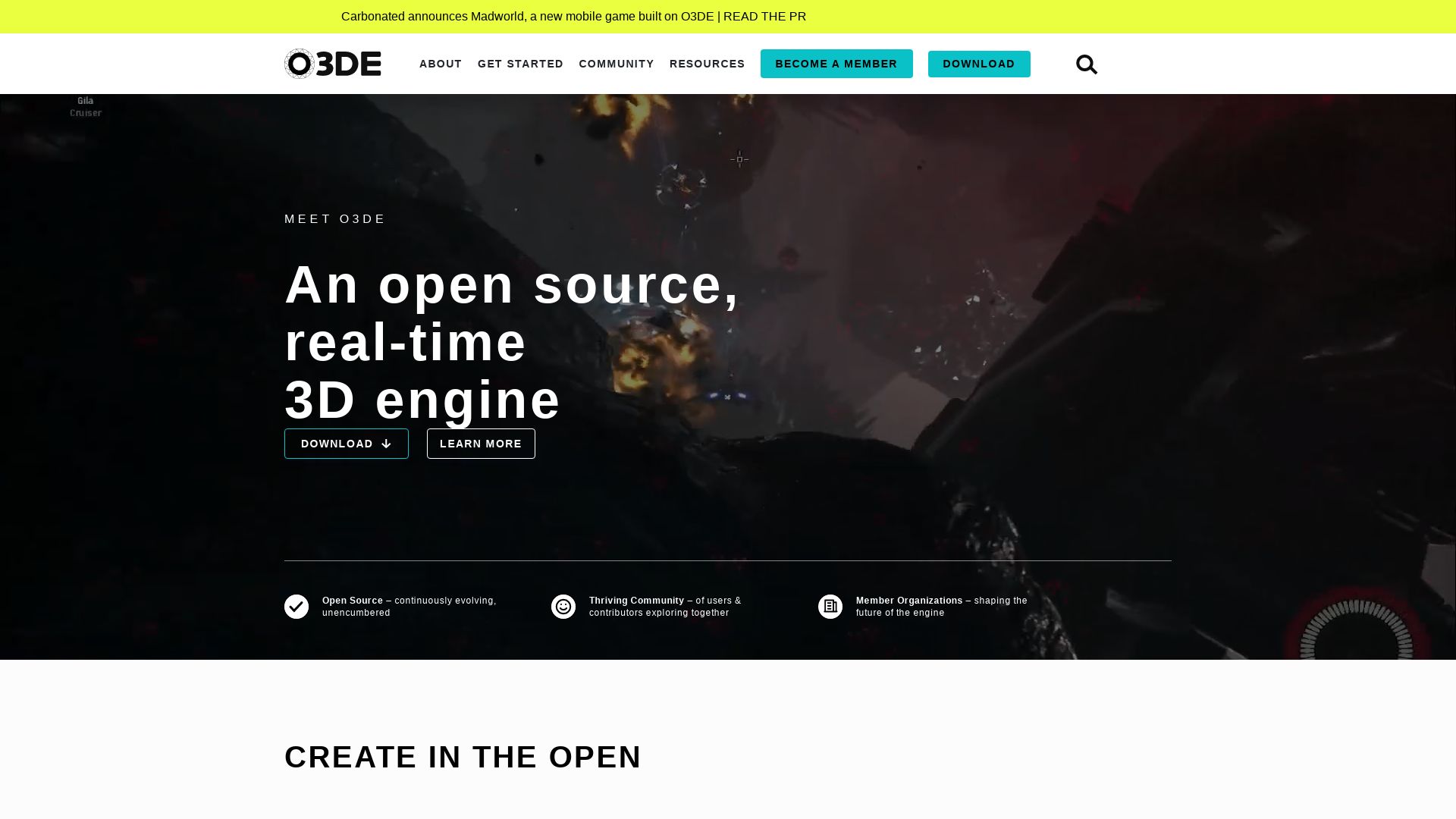
Get ready to meet O3DE, the Open 3D Engine, your ticket to high-performance, interactive experiences, straight from the Open 3D Foundation’s code kitchen. Serving its first batch on July 6, 2021, it’s seasoned with C++, Lua, and Python, and finds its home on several operating systems. It’s the open-source, real-time 3D engine you’ve been waiting for, loaded with features and fuelled by industry moguls like Adobe, AWS, Epic Games, and Huawei. What’s the cherry on top? It’s free – so no need to break your piggy bank!
O3DE Top Features
- Get your hands on a toolkit that lets you simulate physics, animate, and create cinematics. It’s the Swiss Army knife of 3D engines. You just bring the popcorn.
- Open source – Tweak it, extend it, make it dance the Macarena. It’s all yours to play with!
- Here’s a gem – its modular engine and components, composed of Gems (libraries with standard interfaces). Think of it as your personal Lego set for assembling your projects.
- O3DE backs precompiled gems that can be added/removed without needing to recompile the whole engine. It’s as easy as changing your socks!
- A physically based renderer, Script Canvas, or Lua for runtime logic, plus Python scripting support and high-performance math libraries.
- Supports the common development platforms, Android and iOS.
| Written in | C++, Lua, Python |
| Runtime logic | Script Canvas or Lua |
| Platform support | Android, iOS |
O3DE Disadvantages
- O3DE is relatively new, so it’s possible you may stumble upon a few treasures (read: issues) yet to be discovered and smoothed out.
- Despite its roots with Amazon’s Lumberyard, its offspring, the Lumberyard-based game New World, had middling reviews. Still, every engine has a spoiler, right?
- It has a few big rivals—Unreal Engine, Godot, Unity—already hosting the party. But who doesn’t like a little friendly competition?
O3DE Pricing
And now for everyone’s favorite part: the price. Well, keep your wallets in your pockets, folks. O3DE comes at the delightful price of free! Open-source and wallet-friendly, it’s the perfect combination for the budget-conscious game dev.
O3DE Use Cases
Use case 1
Are you eager to build high-performance, interactive simulations for education or research? O3DE lets you create the actual laws of physics! And when you’re done with that, you can even animate results for some visual revelations.
Use case 2
Do you dream of game development? With its high-performance math libraries, and networking capabilities, O3DE is here to catapult your 2D side-scroller into a 3D extravaganza!
Use case 3
If you’re an existing Lumberyard user, migrating to O3DE would be quicker than winning a Mario Kart race. So why not make that transition smoother than your game’s FPS?
Love2D
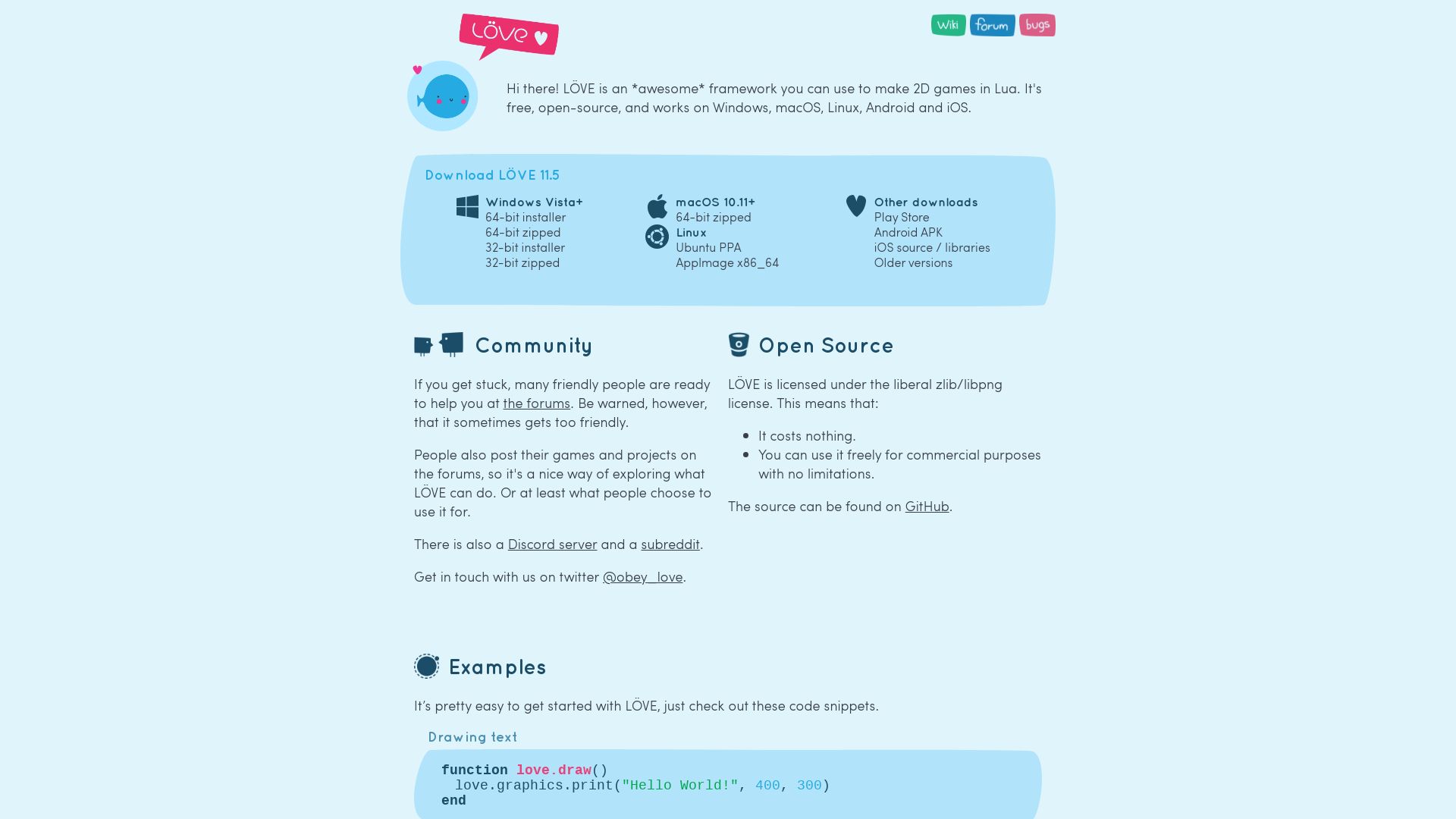
If you’re on the hunt for a free, open-source game framework that has been a gaming darling since 2008, look no further than Love2D. Born from the genius of C++, this engine will let you immerse yourself in the world of 2D game development with its extensive cross-platform support and handy additional features.
Love2D Top Features
- Multi-platform: Whether you’re on FreeBSD, OpenBSD, NetBSD, Windows, Linux, macOS, iOS, Android, Love2D has got your back!
- Wide-ranging compatibility: Gloriously compatible with SDL and OpenGL libraries, and supports OpenGL ES version 2 & 3 from 0.10 version onward.
- Multi-format support: From audio formats like WAV, OGG, MP3, to image variants like PNG, JPEG, GIF, TGA, BMP, Love2D embraces them all readily!
- Incorporated libraries: Box2D for physics, LuaSocket for internet communications, & a plethora more to dive into!
| Version | Features |
| Love2D 11.4 | Stable release leveraging features like joystick controls, GLSL pixel shaders, UTF-8, touchscreens for mobile devices & more! |
| piLöve | A Raspberry Pi specific release with a host of idiosyncratic features! |
| LÖVE2D | A robust 2D-specific engine for dainty game ideas! |
Love2D Limitations
- Exclusive 2D: Caters strictly to 2D, not equipped to handle 3D game creation.
- Compatibility woes: Games on different Love2D versions may not work across platforms.
- Limited Modules: Limited modules available, lack of a graphical interface.
Love2D Pricing
In true disruptive style, Love2D is open source and completely free! It is proudly published under the zlib License.
Love2D Use Cases
Use case 1: Game Development Competitions
Used frequently in game development competitions like Ludum Dare, Love2D is a fantastic choice for developers competing under time pressures!
Use case 2: Educational Purpose
Given its straightforward installation and availability of Lua code snippets, Love2D is very suited for educational purposes and introductory game design courses!
Use case 3: Indie Game Developers
With notable games under its belt like ‘Move or Die’ and ‘Kingdom Rush’, Love2D holds immense potential for indie game developers looking to kickstart their gaming journey!
Heaps

Representing a significant footprint in the game development arena, Heaps is a mature, cross-platform graphics engine designed for creating high-performance games. It is the backbone behind high-profile games like Rushberry Mercs, Voidrun, Nuclear Blaze, and Evoland.
Heaps Top Features
- Developed with Haxe programming language enriching it with portability and integration benefits
- 2D and 3D capabilities catering to varied game design requirements
- High-performance engine powering complex game systems and deep storylines
- Support for various game genres – Arcade, Role Playing, RTS, Turn-Based strategy, and more
- Favoured by known indie developer circles and companies such as Shiro Gaming and Motion Twin
| Major Innovator | Community Association |
|---|---|
| Nicolas Cannasse, one of Haxe’s creators and founder of Shiro Gaming | Largely adopted by the indie game development community, especially post Flash’s demise |
Heaps Limitations
- More of a library than a full-featured game engine when compared with competitors like Godot and Unity
- Requires a learning curve for those unfamiliar with the Haxe programming language
Heaps Pricing
As an open-source engine, Heaps comes free of cost, making it an accessible platform for indie developers and creators.
Heaps Use Cases
Use case 1 – Indie Game Development
Heaps is typically adopted by indie game developers owing to its high-performance, flexibility, and free availability. Games like Dead Cells and Northgard are testaments to its capability.
Use case 2 – Complex Game Systems
The engine’s robustness to power complex systems and narratives makes it a preferred choice for developers seeking to create more intricate gaming experiences.
Use case 3 – Post-Flash Development
Nicely filling Flash’s vacuum, Heaps, with its Haxe pedigree, has become the platform-independent tool of choice, readily favored by the Flash community.
Babylon.js
A revolution in the realm of 3D game engines, Babylon.js is a real-time platform authored by David Catuhe. Under consistent improvements by tech giant Microsoft and various contributors since its launch in 2013, it revamps the 3D graphics experience with high-quality HTML5 display within your web browser.
Babylon.js Top Features
- Stunning 3D modelling, complemented by polygon modeling with triangular faces for impeccable gaming visuals.
- Efficient coding by TypeScript-to-JavaScript compilation and API accessibility for user projects.
- Boosted by solid physics engines, Cannon.js and Oimo, for lifelike collision simulation and real-world physics in games.
- Highly functional animation system including keyframe animation objects and skeletal animations with blend weights.
| Praiseworthy Feature | Details |
|---|---|
| Official repository | Open-source code available on GitHub for access, review, and improvements by the global developer community. |
| Rendering technique | Utilizes physically based rendering and post-processing methods to produce photorealistic images, thus offering eye-catching game visuals. |
| Browser compatibility | Compatible with any HTML5 and WebGL supporting browsers allowing you to exhibit your creations on diverse platforms. |
Babylon.js Downsides
- Restricted application of constructive solid geometry, limiting the dynamics of union, subtraction, and intersection of shell models.
- The designing process can be challenging for beginners due to its complexity.
Babylon.js Pricing
What makes it even more attractive? It’s completely free and open-source, boosting game development without pinching your pocket.
Babylon.js Use Cases
Use case 1 – Virtual World Creation
Whether you’re a pro game developer or a virtual world hobbyist, Babylon.js equips you to create immersive environments with real-world physics and top-notch graphics.
Use case 2 – Product Design
For product designers, it introduces a new way to model and visualize products with unprecedented precision and realism
Use case 3 – Education
In the academe, particularly in medicine, Babylon.js provides an innovative tool for teaching complex concepts through interactive visuals and simulations.
jMonkeyEngine

In the domain of game development, jMonkeyEngine emerges as an unraveled force. A Java-based engine with a minimalistic, code-first orientation and Android compatibility, it’s powered by the NetBeans Platform and aimed at developers.
jMonkeyEngine Top Features
- Capacious support for 3D audio with OpenAL and jmePhonon.
- Various networking solutions include Spidermonkey, Monkey Netty and SimEthereal.
- Uniquely comprehensive physics solutions include jBullet, Minie.
- Boasting an advanced particle capabilities system, providing developers with myriad options.
- Robust terrain libraries for breathtaking game environments.
- High-quality graphics with post-process water and light scattering, alongside bullet physics, normal and specular maps.
| Feature | Details |
|---|---|
| GUI Options | Lemur, Nifty GUI, IGUI, offering comprehensive controls |
| Latest Update | 20th March 2023 with several bugfixes, improved features |
| License | Open source under BSD 3-Clause license |
jMonkeyEngine Limitations
- It’s more inclined to a lower-level game development tool.
- Despite its strengths, it may still fall short compared to its alternatives in certain parameters.
jMonkeyEngine Pricing
A delight to developers, jMonkeyEngine is completely free, open-source under the BSD 3-Clause license. This encourages a vast expanse of possibilities for innovation in game development.
jMonkeyEngine Use Cases
Use case 1
Primarily designed for developers, the engine’s adaptability sits well with developers craving a more structured, code-centric tool.
Use case 2
With a robust library, it’s an ideal pick for creating immersive games replete with detailed terrains, physics, and striking particle effects.
Use case 3
jMonkeyEngine’s versatility extends to educational programs, making it a popular choice for young learners and adults interested in game development.
RPG Maker
RPG Maker, a cornerstone in game-development tools, saw its first release on December 17, 1992. Now renowned for its ease of use, it is a top-notch choice for beginners and RPG enthusiasts looking to dive into game development.
RPG Maker Best Features
- Simple to Use: No coding knowledge is required. Ideal for beginners.
- Robust Character Creation: Provides extensive options for character development.
- Cross-Platform Compatibility: Works on multiple platforms including Windows, Mac, Nintendo, PlayStation, and others.
- Language Support: Written in JavaScript, HTML5 and available in Japanese, Chinese, Korean, English.
| Feature | Details |
|---|---|
| DLCs | Over 200 DLCs available for RPG Maker MV, ranging $5-$25 |
| Community Support | Extensive support and modification sharing. |
| Plugins | Implements different, mostly free, plugins. |
RPG Maker Limitations
- Design Limitations: Game designs are subject to engine’s limitations which may hamper creative execution.
- Requirement for Skilled Developer: Despite its user-friendly nature, a complex game aims could fail without a skilled developer.
RPG Maker Pricing
The pricing of additional features and DLC ranges between $5-$25. The base software might be free or at a nominal cost, including versions like MV or MZ.
RPG Maker Use Cases
Use case 1
RPG Maker is ideal for beginner developers owing to its simplicity and fundamental understanding of role-playing game mechanics.
Use case 2
Story-driven games are a forte of RPG Maker. Developers looking to create story-focused games often choose RPG Maker despite certain limitations.
Use case 3
2D, sprite-based RPGs – For those looking to create games reminiscent of early Final Fantasy titles, the 2D perspective and sprite-based capabilities of RPG Maker come in handy.
Logan Bellbrook
Content writer @ Aircada with a knack for nature & AR/VR/XR. Blogging the intersection of tech & terrain.




